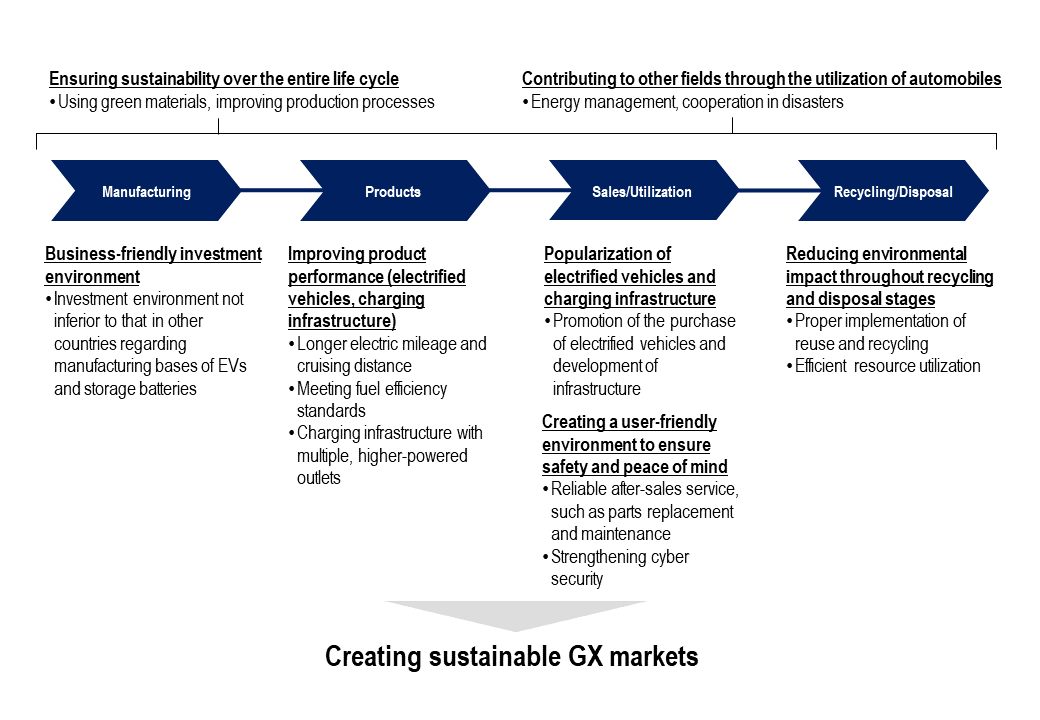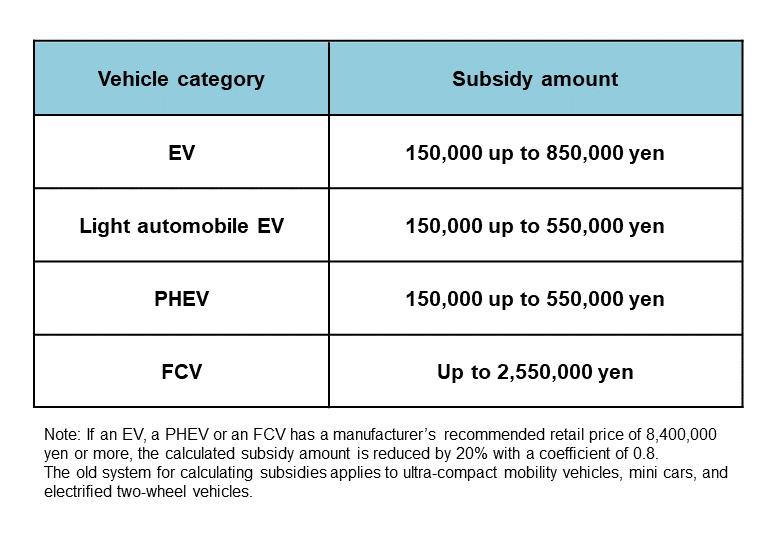Subsidies Upgraded for the Purchase of Clean Energy Vehicles toward the Realization of GX in the Automobile Sector
(Provisional translation)
(English ver.) 2024-08-22

Japan has set a goal for all sales of new passenger vehicles to be electrified vehicles by 2035. Electrified vehicles include electric vehicles (EVs), fuel cell vehicles (FCVs), plug-in hybrid electric vehicles (PHEVs), and hybrid electric vehicles (HEVs.) As they emit less CO2 than conventional cars with internal-combustion engines (ICE vehicles), various kinds of electrified vehicles have been brought to the market. HEVs accounted for about 50% of the domestic sales of new passenger vehicles in FY2023, whereas EVs, FCVs and PHEVs combined had only a 3.5% share. Quite a few people may have the notion that these three types of electrified vehicles are expensive and exclude them from their options for purchasing new cars. In order to popularize these three types of electrified vehicles, we would like to encourage them to take advantage of the Subsidies to Promote the Introduction of Clean Energy Vehicles (a.k.a. CEV Subsidies). With these subsidies granted, people can not only enjoy low purchase prices but also contribute to efforts toward achieving net-zero GHG emissions. This article highlights CEV subsidies that have been upgraded from FY2024.
To achieve the goal of all sales of new passenger vehicles being electrified vehicles by 2035
CO2 emissions from the automobile sector account for about 16% of Japan’s total CO2 emissions. It is essential to promote and popularize clean energy vehicles toward achieving the goal of net-zero GHG emissions by 2050.
As mentioned before, Japan has set a goal for all sales of new passenger vehicles to be electrified vehicles by 2035. Toward achieving this goal, the country has been offering CEV subsidies to support the new purchase of clean energy vehicles.
Creating GX markets in the automobile sector through CEV subsidies
The concept of CEV subsidies has been restructured from FY2024 with major changes made to the evaluation method to determine the amounts of subsidies.
In the past, the amounts of subsidies were determined based solely on vehicle performance, such as the electric mileage (how far the car can go with one kilowatt-hour) and mileage per charge (how far the car can go with the installed batteries fully charged.) The evaluation method has been changed from 2024 to comprehensively assess car makers’ efforts based on the values necessary for the realization of GX in the automobile sector. GX means green transformation from fossil fuel (coal and oil)-centered industrial and social structures to clean energy-centered ones with net zero emissions.
What specifically then are the values necessary for the realization of GX in the automobile sector? In order to achieve GX in the automobile sector, it is essential to create an environment in which people can drive their electrified cars safely and with peace of mind. To this end, charging infrastructure must be developed and after-sales services should also be improved, not to mention the improvement of vehicle performance. Furthermore, life-cycle CO2 emissions from manufacturing to disposal need to be reduced wherever possible in addition to emissions while travelling. It is also expected that electrified vehicles will serve as emergency power sources in disasters. These aspects have been added to the values necessary for the realization of GX in the automobile sector.
This aims for the creation of GX markets in the automobile sector by accelerating efforts by car makers toward creating an environment in which electrified vehicles are utilized sustainably.
Values necessary for the realization of GX in the automobile sector
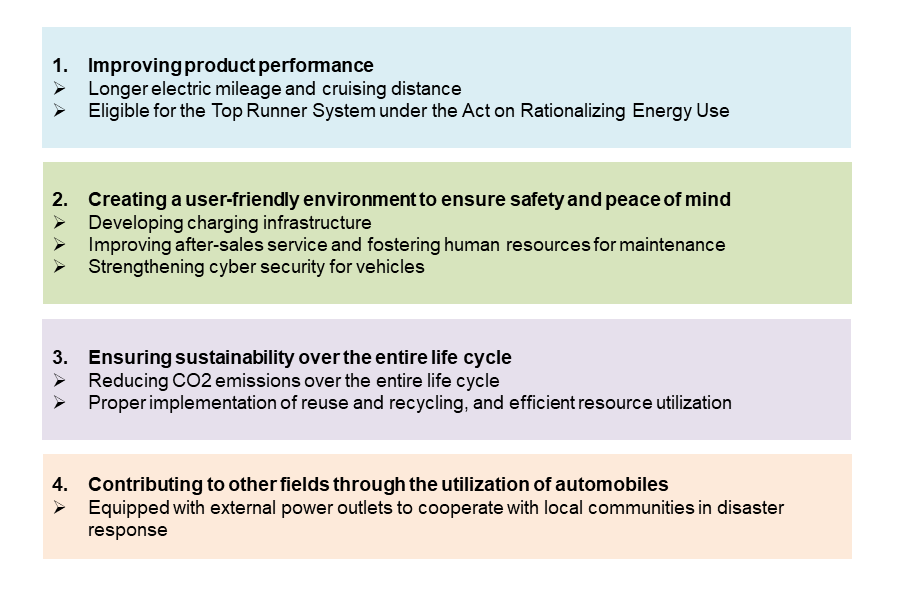
Expanded budget for subsidies, such as a maximum of 850,000 yen for an EV and 550,000 yen for a PHEV
The total budget for CEV subsidies that can be applied for in FY2024 has been increased to 129.1 billion yen. The subsidy amounts are calculated based on the above values that respective vehicle models are expected to create.
The maximum amount of the subsidy for each vehicle category is as follows:
850,000 yen for an EV
550,000 yen for a light automobile EV
550,000 yen for a PHEV
2,550,000 yen for an FCV
New vehicles that are registered with inspection on and after April 1, 2024, are eligible for the new subsidy scheme.
Japan strategically pursues various possibilities for electrified vehicles, rather than focusing only on EVs
The following graph shows the ratios of EV sales in major countries and regions. The ratio of EV sales in Japan is as low as 2% while those in China and in Europe are 18% and 13% respectively.
Changes in the ratios of EV sales in major countries and regions
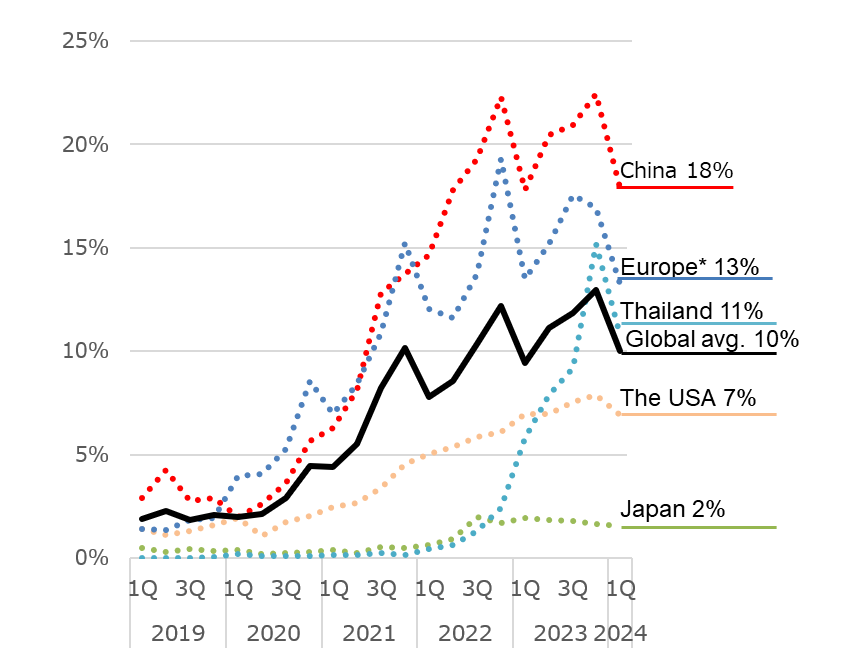
(Source) Marklines
*The figure for Europe represents three countries, namely the UK, France, and Germany
Japan adopts a policy of promoting not only EVs but also other types of electrified vehicles, such as FCVs, PHEVs and HEVs.
Each type of electrified vehicle has its own strengths and weaknesses in terms of cruising distance, charging time/filling time, cost, and CO2 emissions. Taking into account such strengths and weaknesses, Japan aims to utilize each type of electrified vehicle in the right place in society, such as light automobile EVs for short distance travelling and FCVs for long distance bus routes.
Strengths and weaknesses of each type of electrified vehicle
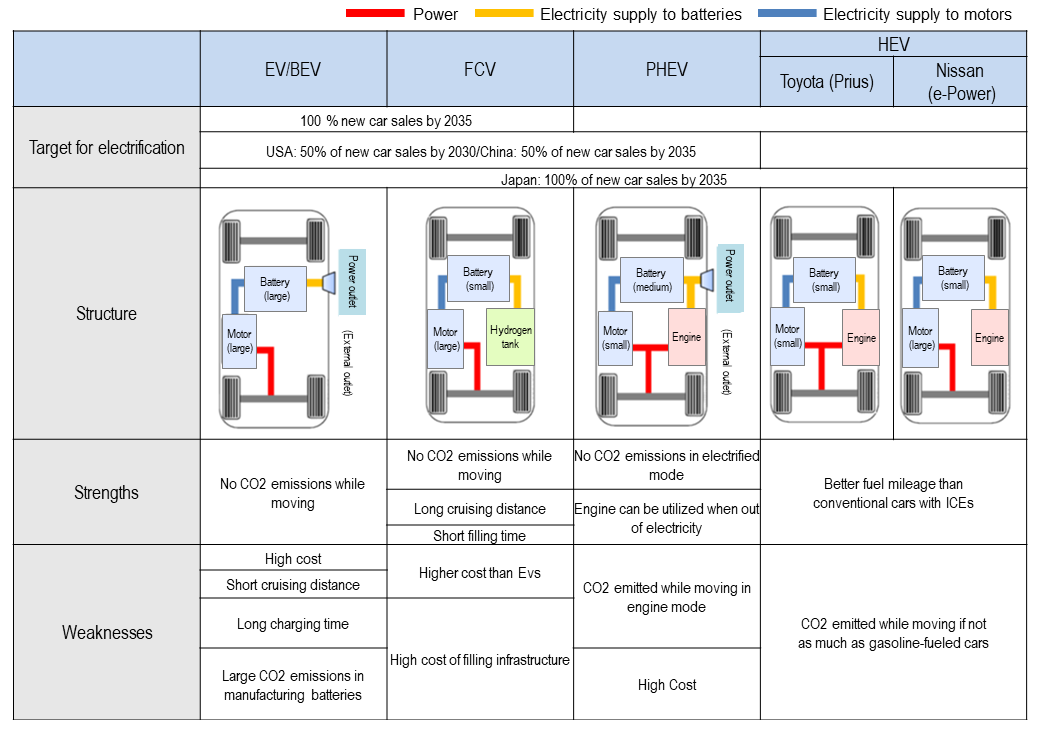
Note: The definition of a ZEV (zero emission vehicle) varies from region to region.
(Source) Created by the Ministry of Economy, Trade and Industry based on published information
Since there is no perfect technology at the moment for achieving GX in the automobile sector, R&D for each type of electrified vehicle still needs to be advanced. For instance, in order to decarbonize HEVs, synthetic fuel (e-fuel) is under research toward commercialization by the early part of the 2030s. Furthermore, next-generation batteries are being developed for EVs and PHEVs. A large-scale hydrogen supply chain needs to be built for the popularization of FCVs.
The Green Innovation Fund is being utilized to accelerate the development of these technologies. We are taking various policy measures for the realization of GX in the automobile sector, promoting innovation on the supply side, and offering subsidies on the demand side for the purchase of electrified vehicles toward their solid popularization in society.
Divisions in Charge
About this article
Automobile Division, Manufacturing Industries Bureau, METI
About the Special Contents
Research and Public Relations Office, Commissioner’s Secretariat, ANRE
![]() The original Japanese text of this article; Click here
The original Japanese text of this article; Click here
